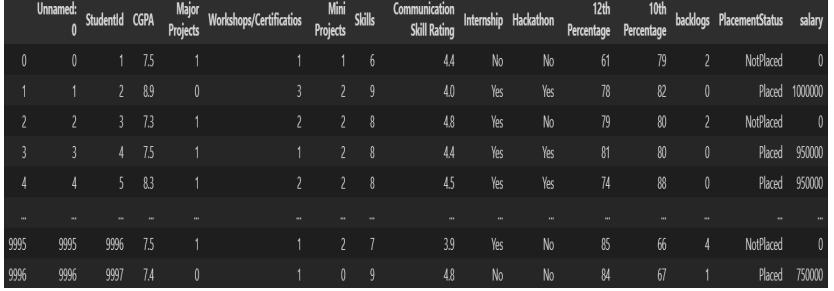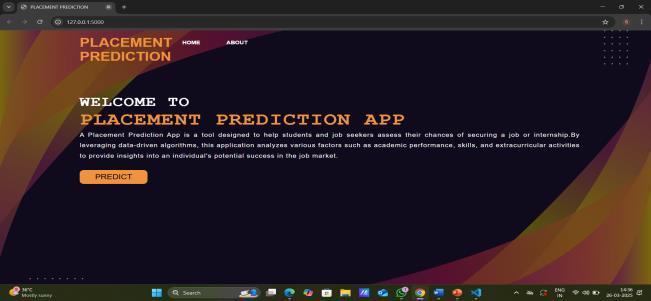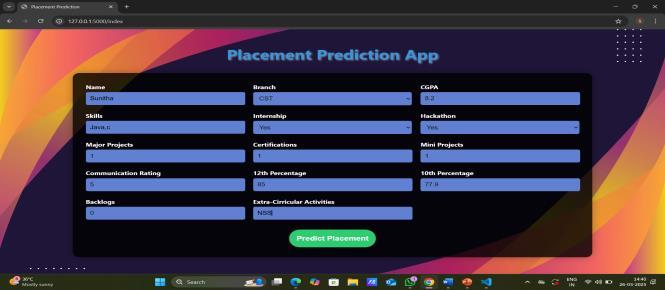
International Research Journal of Engineering and Technology (IRJET) e-ISSN:2395-0056
Volume: 12 Issue: 04 | Apr 2025 www.irjet.net p-ISSN:2395-0072


International Research Journal of Engineering and Technology (IRJET) e-ISSN:2395-0056
Volume: 12 Issue: 04 | Apr 2025 www.irjet.net p-ISSN:2395-0072
Pallavi Satya Durga Anki1 , Anil Kumar Reddy Tetali2 , Tejaswini Mesaala3 , Kotasatyavathi Kodamanchili4 , Sunitha Dhannani5 , Laxmi Harika Karri6
1 Department of CST, Sri Vasavi Engineering College(A), Pedatadepalli, Tadepalligudem-534101
2 Assistant Professor, Department of CSE, Sri Vasavi Engineering College(A), Pedatadepalli, Tadepalligudem-534101
3 Department of CST, Sri Vasavi Engineering College(A), Pedatadepalli, Tadepalligudem-534101
4 Department of CST, Sri Vasavi Engineering College(A), Pedatadepalli, Tadepalligudem -534101
5 Department of CST, Sri Vasavi Engineering College(A), Pedatadepalli, Tadepalligudem-534101
6 Department of CST, Sri Vasavi Engineering College(A), Pedatadepalli, Tadepalligudem-534101
Abstract: Developing a placement prediction model through machine learning involves analyzing historical data, academic performance, and skills to identify key factors influencing student placements. By employing advancedalgorithms,themodel extractscomplexpatterns and makes accurate predictions about a student’s likelihoodofsecuringa job. Thissystemprovidesvaluable insights tostudents,helping them enhance their academic and professional skills, while also assisting educational institutions in refining training programs and placement strategies. Additionally, recruiters can leverage this datadriven approach to identify suitable candidates efficiently. By bridging the gap between student capabilities and industry demands, the model ensures informed decisionmaking,ultimatelyimprovingplacementsuccessrates.
Keywords: Placement Prediction , Machine Learnin, AcademicPerformance,SkillAnalysis,SuccessRates
1. Introduction:
Campus placements are a critical phase in a student’s academic career, influencing future employment opportunities. Predicting placement outcomes, however, remains a complex challenge. Traditional methods often relyonsubjectiveassessmentsandmanualanalysis,which can be inconsistent and inefficient. With the rise of machine learning, predictive models can now analyze historical data, academic performance, and skills to make more accurate predictions. This paper proposes a Placement Predictionmodelthat utilizesmachinelearning algorithms Random Forest, K-Nearest Neighbors (KNN), Decision Trees, Gradient Boosting, and AdaBoost to forecastplacementoutcomesforpre-finalyearengineering students. By evaluating key features such as academic performance, technical skills, internships, and extracurricular activities, the model provides valuable insights for students to improve their chances of securing
placements. Additionally, it helps educational institutions optimize training and placement strategies to better align with industry needsThe goal is to bridge the gap between student capabilities and industry demands, ultimately improving placement success rates and supporting informed decision-making for students and institutions alike.
2. Literature Survey:
Predicting student performance has gained significant attention with the growth of machine learning and data mining techniques in education. By leveraging various machine learning models, educators can identify at-risk students and take proactive steps to improve academic outcomes. Below is a review of key research in this domain:
[1] B.V. Krishna Prasad, B.S. Sandeep, "A Predictive Model for Student Performance in Higher Education Using Machine Learning Techniques," International Journal of Computer Applications,2019.Thispaperexploresmachine learning algorithms like Decision Tree, SVM, and Naive Bayes to predict student performance based on historical data and academic performance, aiding in early identificationofat-riskstudents.
[2] S. R. A. Syed, T. S. Manoharan, "Academic Performance Prediction Using Machine Learning Algorithms," International Conference on Data Science and Engineering, 2018. This research highlights the use of Logistic Regression, Decision Trees, and Neural N for academic performance prediction. The study emphasizes how predictive models help identify students in need of academicsupport.
[3] Rajesh Kumar, R. Jeyavannan, "Prediction of Student’s Performance Using Classification Algorithms," Journal of Engineering Science and Technology Review, 2017. The

International Research Journal of Engineering and Technology (IRJET) e-ISSN:2395-0056
paper uses Random Forest and SVM classification algorithms to predict final grades,showcasing the models' highaccuracyinforecastingstudentperformance.
[4]PushpaSK,ManjunathTN,MrunalTV,AmartyaSingh, CSuhas,"ClassResultPredictionusingMachineLearning," International Conference on Smart Technology for Smart Nation, 2017. This paper predicts class results based on past academic performance and internal exam scores, applying models like SVM, Naive Bayes, Random Forest, and Gradient Boosting to determine student success or failure.
[5] M. Rajesh, S. V. Kumar, "Prediction of Student’s Academic Performance using Data Mining Techniques," International Journal of Engineering and Technology, 2016. This paper reviews data mining techniques such as SVM, Naive Bayes, and Decision Trees to predict student academicperformance,providingusefulinsightsfortimely intervention.
3.1 Existing System: The existing placement system primarily relies on academic performance, such as CGPA and exam scores, to determine placement opportunities, ignoring other important factors like technical skills, internships, and communication abilities. This leads to an inefficient and biased process, where manual evaluations lack predictive insights and fail to offer personalized recommendations.Studentsarenotprovidedwithtailored feedback to improve their employability, limiting their chances of success. Furthermore, the absence of machine learning integration results in inaccurate predictions and missed opportunities for data-driven decision-making. Consequently, the system's narrow focus on academics hinders its ability to provide a comprehensive assessment andsupportstudents’careerdevelopmenteffectively.
3.2 Proposed System :Our proposed system enhances placement predictions by incorporating a wide range of factors such as academic performance, technical skills, internships, and projects. We employ machine learning algorithms like K-Nearest Neighbors (KNN), Random Forest, Decision Trees, AdaBoost, and Gradient Descent to analyze comprehensive student data and provide more accurate and reliable placement predictions. The system evaluates these multiple dimensions of a student's profile, offeringamoreholisticviewbeyondjustacademicscores. These algorithms are evaluated for performance based on common metrics such as accuracy, precision, recall, F1 score, and AUC-ROC. We compare the accuracy and performance of each model and select the one with the
Volume: 12 Issue: 04 | Apr 2025 www.irjet.net p-ISSN:2395-0072 © 2025, IRJET | Impact Factor value: 8.315 | ISO 9001:2008
highest accuracy for final prediction. To optimize performance, we conduct hyperparameter tuning for each algorithm to ensure we extract the best possible results. AdaBoost, in particular, is used to combine multiple weak classifiers to create a more robust and accurate model. Gradient Descent is employed as an optimization techniquewithinmodelslikeRandomForestandDecision Trees to minimize prediction errors and improve overall accuracy. By leveraging these advanced machine learning techniques, the system generates personalized feedback for students, helping them identify areas for improvement in technical skills, internships, and other key areas. Additionally, educational institutions can use the insights from our model to better align their training programs with industry requirements, enhancing student employability. For recruiters, our system offers a data-driven approach to shortlist candidates, saving time and resources in the placement process. Ultimately, our system bridges the gap between student capabilities and industrydemands,improvingplacementsuccessratesand enablingmoreinformeddecision-makingforbothstudents andinstitutions.
Data Collection: We collect student data, including academic performance (CGPA, exam scores), technical skills,internships,andprojectdetails.
Data Preprocessing: The collected data is cleaned to handle missing values, normalize features, and split into trainingandtestingsets.
Model Development: We implement multiple machine learning models K-Nearest Neighbors (KNN), Random Forest, Decision Trees, AdaBoost, and Gradient Descent. Each model is trained and optimized using hyperparametertuningtomaximizeperformance.
Model Evaluation: The models are evaluated using metrics such as accuracy, precision, and recall to ensure reliablepredictions.
Prediction and Feedback: Oncethemodelsaretrained, they generate personalized placement predictions and provide students with feedback on areas for improvement (e.g.,technicalskills,internships).
Deployment :The system is deployed as a web application using Flask, allowing students to input their data and receive real-time predictions and personalized recommendations.

Volume: 12 Issue: 04 | Apr 2025 www.irjet.net p-ISSN:2395-0072
5.Results:

1: PlacementPredictionDataset




6.Conclusion:
Placement prediction system is a system which predicts theplacementstatusoffinalyearB-Techstudents.Fordata analysis and prediction different machine learning algorithms are used in the python environment. We analyse the accuracy of different algorithms and it is shown in the above table. It is clear that Random Forest gives an accuracy of 95. Logistic Gradient Descent is also good which gives an accuracy of 94.59 based on the given dataset. The accuracyofMachinelearning algorithms may differ according to the dataset. From the result from our analysis it is clear that Random Forest ,Gradient Descent KNN ,Decision Tress are good for binary classification problems since they all give accuracy of above 90. Some recruiters consider GATE scores and history of backlogs which we didn’t include in our dataset. In such rare cases theseresultsmaychange.
References:
[1] B.V. Krishna Prasad, B.S. Sandeep, "A Predictive Model for Student Performance in Higher Education Using Machine Learning Techniques," International Journal of Computer Applications,2019.
[2] S. R. A. Syed, T. S. Manoharan, "Academic Performance Prediction Using Machine Learning Algorithms," International Conference on Data Science and Engineering, 2018.
[3] Rajesh Kumar, R. Jeyavannan, "Prediction of Student’s Performance Using Classification Algorithms," Journal of Engineering Science and Technology Review,2017.
[4]PushpaSK,ManjunathTN,MrunalTV,AmartyaSingh, CSuhas,"ClassResultPredictionusingMachineLearning," International Conference on Smart Technology for Smart Nation,2017.

International Research Journal of Engineering and Technology (IRJET) e-ISSN:2395-0056
[5] M. Rajesh, S. V. Kumar, "Prediction of Student’s Academic Performance using Data Mining Techniques," International Journal of Engineering and Technology,2016.
[6] Breiman, L., "Random Forests," Machine Learning, vol. 45,no.1,pp.5-32,2001.
[7] Freund, Y., & Schapire, R. E., "A Decision-Theoretic Generalization of On-Line Learning and an Application to Boosting," Journal of Computer and System Sciences,vol.55, no.1,pp.119-139,1997.
[8]Hastie,T.,Tibshirani,R.,&Friedman,J., The Elements of Statistical Learning,Springer,2009.
[9] Bishop, C. M., Pattern Recognition and Machine Learning,Springer,2006.
[10]Pedregosa,F.,etal.,"Scikit-learn:MachineLearningin Python," Journal of Machine Learning Research,vol.12, pp. 2825-2830,2011.
Volume: 12 Issue: 04 | Apr 2025 www.irjet.net p-ISSN:2395-0072 © 2025, IRJET | Impact Factor value: 8.315 | ISO 9001:2008 Certified Journal | Page1042